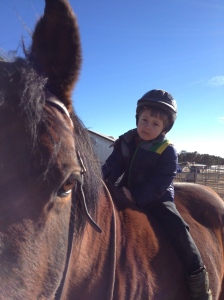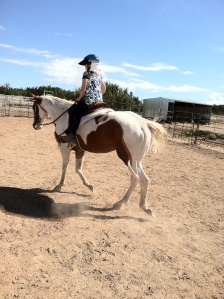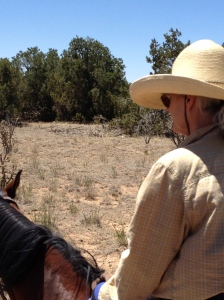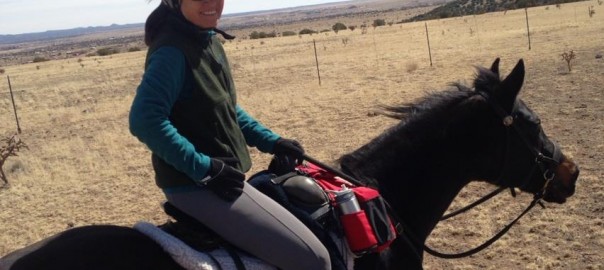Riding is the next step in our relationship with our horse. Working with relationship on the ground comes first, then the saddle.
The relationship established with Liberty Foundations should follow into the saddle, so that the same rules apply basically – you are not hauling your horse around — the horse is a willing companion.

Once that’s satisfied, there is the issue of comfort in the saddle. Being in the saddle presents its own set of unique challenges that standing on the ground does not. Areas of restriction emerge that you didn’t know you had. These areas can emerge in the neck, shoulders, arms, hands, pelvis, legs, knees and feet. It is good to do an overall assessment of where the tension is being held in your own body once you get in the saddle. The same sorts of restrictions are in horses, so the assessment once seated can include this overview of what might be tight in the horse. The tightness may not reveal itself until the horse is moving or he resists moving.
I work with people with varying degrees of flexibility on the ground and in the saddle. The saddle or bareback work is different than working with people in my office because the joints are stressed in different ways. If you have ridden all your life, there are things that have happened riding that will take their toll as you get older. If you’ve had traumatic accidents, the work is even more necessary.
I do sessions on Horses and Riders together – sometimes with the rider out of the saddle first, and with the rider in  the saddle. We work on connecting the rider’s body with the horse’s body both physically and energetically. This is not something taught in riding lessons, in rider biomechanics, although there is great value in each of these things. This is another animal entirely.
the saddle. We work on connecting the rider’s body with the horse’s body both physically and energetically. This is not something taught in riding lessons, in rider biomechanics, although there is great value in each of these things. This is another animal entirely.
I’ve had great riding instructors who have supported my body in wonderful ways, but this work is unique in that it is Ortho-Bionomy on Horseback. It is a look at how we are connected to the horse on horseback on a deeper level, spine to spine, nervous system to nervous system. Because I have received tons of Ortho-Bionomy and practice it, I can also figure some ways to help my posture in the saddle and my connection.
Very often, merely thinking about or visualzing a change in posture or movement can make it better. There are places where biomechanics – the study of human or horse motion in our cases – can inform how the body heals.
Exploring the range of motion of each limb, feet, hands, the torso, neck and head gives the rider some options in terms of flexibility, and can help the horse. The position that is most acceptable or considered “standard” may not be a position your body can go in right now. We work with where the body is in its journey – is the leg and foot sticking out laterally away from the horse’s side? Can you make contact with both thighs on the horse comfortably? Do you list off to one side while riding? Does any part of your body hurt while riding or after riding? Does anything get better with or after riding?

One woman reported to me that her hip dysplasia was more tolerable after riding. To me, that shows me that doing something she loves “self-corrects” her body to the position she is in on horseback and gives her great relief.
In my own case, after I suffered a pelvic fracture in 2010, I needed help getting my body right to be on horseback. My mentor and colleague Zarna Carter did a series of non-force, isometric, postural exercises with me in the saddle.. Each time my horse and I moved together the information from the movements integrated more deeply. The horse helped me find my seat and improved the mobility of my pelvis. My body re-established relationships between its parts – pelvis, seat, legs and feet – and the upper body. My ability to ride went quickly from five minutes in the saddle to two hours.
If you are interested in scheduling one of these sessions for yourself and your horse, contact me susansmith@orthohorse.info or through this blog.
Related post:
10 tips to riding horseback for the rest of your life
For more on Ortho-Bionomy visit my website www.orthohorse.info or www.ortho-bionomy.org
****
(copyright: Susan Smith, OrthoHorse)
Services: Bodywork (Ortho-Bionomy for people, Equine Ortho-Bionomy): private sessions, tutorials, phone consultations, Horse & Rider sessions, distance healing communication and gift certificates
Liberty Coaching: clinics, mini-clinics, workshops, private and semi-private sessions, tutorials, consultations: by appointment: 505.501.2478 or emailing susansmith@orthohorse.info Scheduling now. Contact me for details.
September 26 – Spirit Horse Ranch – Private Liberty Lessons & Ortho-Bionomy for both people and horses. OrthoHorse Tutorial 9-12. Contact me 505-501-2478 or Ruella at 405-771-4274 (ruella@libertyfoundations.com)
September 27-28 – Spirit Horse Ranch Two-Day Liberty Foundations Clinic, Oklahoma City, Oklahoma – Engaging the Hearts and Minds of Horses. Susan Smith and Ruella Yates, co-teaching. Contact me 505-501-2478 or Ruella at 405-771-4274 (ruella@libertyfoundations.com)
October 7: Liberty Foundations Online classes – beginning and advanced – offered by Susan Smith (October 7-beginning), four calls, and Ruella Yates (October 7-advanced), Horses at Liberty Online and Spirit Horse Ranch Online. PayPal button available on my website homepage and on the Events page. Contact me for other payment arrangements.
December 13-14 – Horses at Liberty Weekend Clinic, DeLand, Florida – Bring your Horse into Deep Working Connection with Liberty Horsemanship. Instructor: Susan Smith. Contact Anne Daimler tdaimler@cfl.rr.com (386-822-4564) Susan at susansmith@orthohorse.info (505-983-2128 or cell 505-501-2478) 9:00-4:30 p.m.
Susan is a member of the Independent Liberty Trainers Network. libertytrainersnetwork.com/




